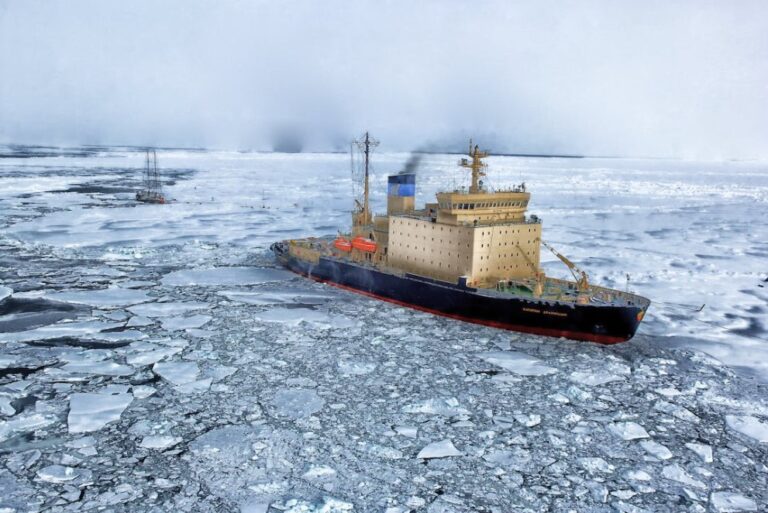It is well known that the Arctic is now (and unfortunately) warming, but less public knowledge is the fact that the climate changes taking place in the area are ironically creating the conditions for a warming of the “geopolitical climate” of the region.
In fact, from an area of the planet relatively little affected by disputes and conflicts, in recent years there has been a notable increase in political-economic interests on the part of states overlooking the area (and beyond).
Table of Contents
The future of the Arctic region
The reasons stem precisely from global warming. The Earth’s poles are more sensitive to any change in the planet’s climate. Faced with ongoing global warming, the poles are warming faster than the rest of the planet and in the Arctic it seems to be happening even more rapidly.
While the causes of this event are multiple and not only linked to the concentration of greenhouse gases (which still remains the predominant one), the main effect is quite obvious: the decline of sea ice. In recent decades, the Arctic Ocean has been melting faster than it refreezes in winter, hitting a low in 2018 with less than 1% of ice four or more years old.
The prospect of a milder climate has reawakened interest in the extraction of resources present in the area, not only in the eight Arctic nations (United States, Canada, Iceland, Norway, Sweden, Finland, Russia and Denmark) with their territorial disputes and on the attribution and exploitation of the respective exclusive economic zones.
But also of much more distant countries such as China, which has explicitly shown its desire to extract natural resources in Greenland.
New commercial opportunity due to climate change
But it is not just the exploitation of resources. The almost total disappearance of multi-year ice shelves has opened up new opportunities that were previously impracticable even in maritime transport.
In recent years, numerous trials of Arctic routes have been carried out which would allow such savings in time and costs to potentially revolutionize global trade.
There are three potential key shipping routes crossing the Arctic:
- the Transpolar Sea Route (TSR), which passes over the North Pole;
- the Northwest Passage (NWP), along Canada’s northern border;
- the Northern Sea Route (NSR), which cross Russia’s long Arctic coast.
Read also: World trade: why maritime transport is still crucial today
The Nordic routes of trade
The Transpolar Sea Route (TSR)
The Transpolar Sea Route, although the most direct route for trans-Arctic expeditions, has never managed to become a viable option due to multi-year ice floes requiring an icebreaking escort and exorbitant insurance costs.
The most recent climate trends, however, could not only revitalize the TSR but push for investments in the infrastructure necessary for its operation. Numerous studies now predict that the route will be 100% ice-free in the years following 2045.
According to The Future of Arctic Shipping Along the Transpolar Sea Route by Malte Humpert and Andreas Raspotnik: “a ship going from Tokyo to Rotterdam can reduce the its speed by 40% and still arrive in Japan at the same time as a ship sailing at full speed through the Suez Canal.”
The Northwest Passage
The Northwest Passage, a shortcut from Europe to East Asia via the North American continent, has been sought by explorers since the 16th century. The NWP consists of a northern and southern route. Explorer Roald Amundsen completed the first transit of the route in 1906.
On August 21, 2007, the route opened to ships without the need for an icebreaker for the first time in human history. Given the potential reduction in travel distance, the Northwest Passage could become the choice of many freighters in the future.
The main element of uncertainty about the NWP is regarding its international status. For Canada the passage is part of internal waters while Washington considers it an international strait. Given the advantages of both positions, greater use of that route could escalate the dispute.
The Northern Sea Route
The Northern Sea Route was developed in 1932 and enjoyed significant investment during the Second World War as a vital supply route in support of the Eastern Front. The route reduces the distance from Europe to China by 40% compared to the standard route through the Suez Canal.
The NSR is the most viable of the three Arctic routes also due to its infrastructure already capable of supporting potential traffic from large maritime lanes. The NSR, in fact, was at the center of Putin’s development plans in the Arctic with a strong increase in investments in icebreaker fleets and port infrastructure.
The ongoing climate change therefore seems to overturn the classic image of the Arctic that each of us has. From a land of scientific research, far enough from the hot zones of geopolitics, to a new crossroads of global trade, capable of thawing old tensions and create new ones.
Read also: Why the Houthi attacks in the Suez Canal pose risk of global commercial chaos












